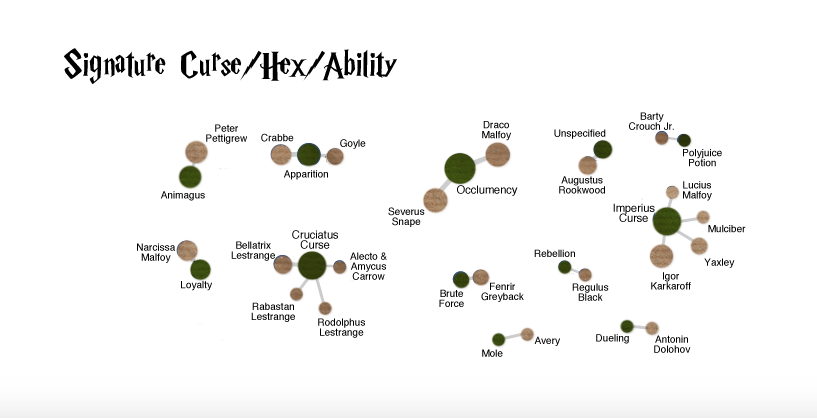“… And Harry too looked ahead at the skull, and fear swelled inside him like a venomous bubble, compressing his lungs, driving all other discomfort from his mind….” (Rowling, HBP 582).
The Death Eaters rely on the Dark Arts, manipulation, or power through privilege. To move around, they use the the spell “apparate.” Each Death Eater can perform the spell, and it’s as common as “accio” in the books, or the spell to create the Dark Mark, “morsmorde.” According to Colbert, it means to “take a bite out of death” in French.
The next most and unique ability in the Death Eater skill sets are the “Unforgivable Curses.” Avada Kedavra is the killing curse, Imperius (Imperio) is the controlling curse, and Cruciatus (Crucio) is the torturing curse. Each curse allows the wandholder total control over the victim. Each curse requires extensive ability, in magic and in power. You have to truly mean the curse for it to succeed. You must truly want to hurt or control someone. Young witches and wizards are taught early on to avoid casting the curses, given their highly hazardous potential for destruction. In the fourth year, Defense Against the Dark Arts professor Mad-Eye Moody led a class on them:
“‘Now… those three curses– Avada Kedavra, Imperius, and Cruciatus– are known as the Unforgivable Curses. The use of any one of them on a fellow human being is enough to earn a life sentence in Azkaban” (Rowling, GOF 217).
Avada Kedavra is the ultimate dark curse. Although the phrase is garble jarble at first read, its comes from a real language: “… The Avada Kedavra curse derives from a phrase in ancient an ancient Middle Eastern language called Aramic. That phrase, abhadda kedhabhra, meaning ‘disappear like this word,’ was used by ancient wizards to make illnesses disappear” (Colbert 17). In the Harry Potter plot, it makes people disappear, and kills them.Noticeably used by Lord Voldemort, other Death Eaters favor it as well. This curse made Harry’s scar, and gives him the nickname “The Boy Who Lived.” Voldemort cast it on James, Lily, and Harry Potter during the First Wizarding War. In the Second Wizarding War, It is what Professor Snape uses to kill Albus Dumbledore.
The Imperius curse is used frequently by Death Eaters. When questioned about their involvement with Lord Voldemort , many blamed their involvement on control through the Imperius Curse. Most were lying. When Voldemort regains power, in the Deathly Hallows storyline, the Death Eaters gain control over the entire Ministry of Magic by casting the Imperius curse on Pius Thicknesse. Although a strong witch or wizard can resist the curse, it is extremely difficult to do so.
The Cruciatus curse is frequently utilized as a way to gain information, but also for fun by the Death Eaters. The Longbottom’s torture was through the Cruciatus Curse. Bellatrix Lestrange is a major fan of the curse, using it to torture the Longbottoms as well as on Hermione Granger. During the Second Wizarding War, the curse was used on students at Hogwarts by the Carrows, who become the Defense Against the Dark Arts instructors after Voldemort went into power.
Other than specific curses and hexes, most Death Eaters use their position in society to manipulate people into following their orders or spread their ideas. The Death Eaters also have members who work inside the ministry in their “unmasked” lives. Macnair, Rookwood, Yaxley, and Avery all have inside details given their Ministry of Magic day jobs. They influence the government, which influences the people.
Snape’s position as a Hogwarts professor allows him to keep a close watch on Harry Potter. It also allows him to influence what the students learn. Yikes. This ability to spy on the enemy while posing as a friend is essential to Snape’s role. Lucius Malfoy is the major example of Death Eater influence through societal status. His wealth allows him considerable control over the Ministry as well as Hogwarts– dangerous, given the whole shaping young minds thing. Again, Pure-blood power involves entitlement and privilege, which we expanded on in our other posts.
Colbert, David. The Magical Worlds of Harry Potter: A Treasury of Myths, Legends, and Fascinating Facts. New York, New York: Berkley Group, 2001. Print.
Harry Potter and the Goblet of Fire. Dir. Mike Newell. Perf. Daniel Radcliffe, Emma Watson, Rupert Grint. Warner Bros., 2005. Web.
Rowling, J.K. Harry Potter and the Goblet of Fire. New York: Scholastic, 2000. Print.
